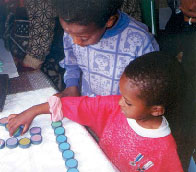Colour vision
 Colour vision measurements often reveal surprising new information. In children who have vision loss due to corneal opacities, or cloudy lens or vitreous and in whom the retinal functions are normal, colour vision may be quite normal. On the other hand, children with mild optic nerve lesions may confuse colours despite fairly good visual
acuity. In the assessment of colour vision, we can use two techniques described in the instruction booklet of the Panel 16 test.
Colour vision measurements often reveal surprising new information. In children who have vision loss due to corneal opacities, or cloudy lens or vitreous and in whom the retinal functions are normal, colour vision may be quite normal. On the other hand, children with mild optic nerve lesions may confuse colours despite fairly good visual
acuity. In the assessment of colour vision, we can use two techniques described in the instruction booklet of the Panel 16 test.
They are thus only briefly described here:
1. Place every 3rd cap of the test, i.e. caps "pilot", 3,6,9,12 and 15, on the table in front of the child. Take the pair of one of the six caps, e.g. cap #6 and ask the child to find out which cap on the table has the same colour. The child may hold the referral cap in one hand and pick the caps on the table one by one to compare with the reference cap close to the eyes, if needed. Record which colours are matched correctly and which colours are confused (e.g. "matches pilot, 3,9 and 15 correctly, confuses 6 and 12"). Then place on the table caps 1, 4, 7, 10, 13 and the next time caps 2, 5, 8, 11, 14 to find out which colours might be confused by the child. This gives you information which colours will be confused in the educational materials and also in clothing and other objects. During testing the lighting should be comparable to light at a window facing North (in Northern hemisphere) at noon and the surface below the caps black, grey or white.
2. Older children can be tested like adults and are asked to sort the caps on the table so that the child first finds the cap that is closest in colour to the "pilot" cap, then the cap that is closest to the previous cap continuing until all caps are arranged in a line. The test situation is easiest if the tester moves the caps and the child can concentrate on matching. When the caps are then turned over you see the order of the numbers and can draw the result on the recording sheet. In the visually impaired children colour confusions may be irregular so you may not find a clear axis in the recording but you see between which colours the confusions occur.
If the child sees colours so poorly that matching is not possible, the child's ability to match bright basic colours needs to be assessed. This test situation can use sorting of any bright coloured materials, most often colourful pieces of paper. (Screening tests, like the Ishihara test, are diagnostic tests not suitable for assessment of disability, because they do not measure colour deficiencies other than in the red-green axis and even in that axis the test result is not quantitative.)
WARNING: Although the colour surfaces on the caps are covered with a thin protective layer, colour vision test is the most vulnerable of all vision tests. Never leave it in sunshine and ask the child to touch only the sides of the colour caps.
Previous Chapter 
|
 Next Chapter Next Chapter
|